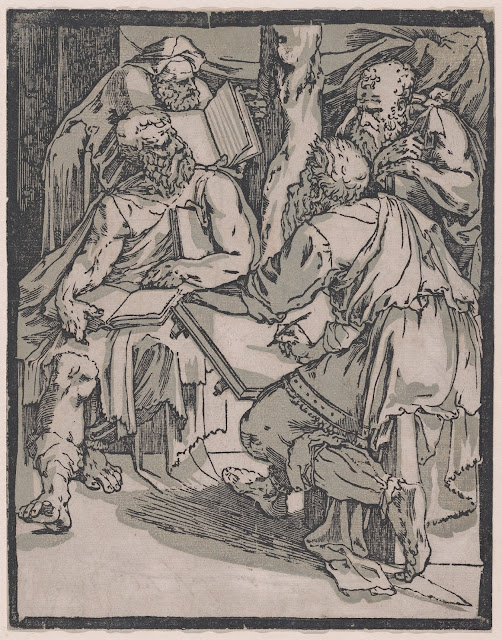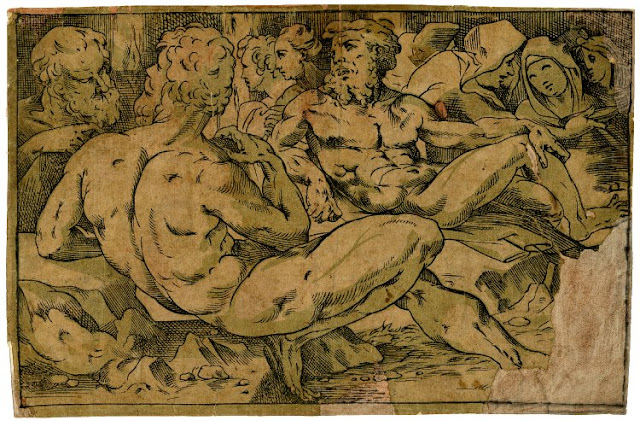 |
| Ugo da Carpi after Raphael David and Goliath ca. 1510-30 chiaroscuro woodcut Metropolitan Museum of Art, New York |
 |
| Ugo da Carpi after Raphael Death of Ananias 1518 chiaroscuro woodcut Metropolitan Museum of Art, New York |
"Nor was there lacking one who took it into his head to make woodcut prints that seemed to be fashioned with a brush in the guise of chiaroscuro, which was a clever and difficult thing; and this one was Ugo da Carpi, who, even if he was only a mediocre painter, nonetheless had the sharpest talent for other marvelous whims. . . . Ugo was the first to try, and he succeeded well, to work with two blocks, one of which, used like a copper plate, served for hatching the shadows, and with the other he made the color tones, because cutting into the block in intaglio he allowed the white paper to show, which seemed, when it was printed, to be highlights printed in white."
– Giorgio Vasari, Lives of the Most Excellent Painters, Sculptors and Architects (1568), translated and quoted by Evelyn Lincoln in The Invention of the Italian Renaissance Printmaker (Yale University Press, 2000). Evelyn Lincoln continues below:
"Vasari's slightly unintelligible description shows that it was not a simple thing, even for an artist, to visualize a four-color woodblock print. Besides the separation of colors, or tones in this case, there were the practical concerns of good register between the blocks, and cutting the wood in negative. Even using prints of each block pasted on succeeding blocks as cutting guides did not ensure that the carving would be a simple technical job. The incised area of a copper engraving results in a positive printed line, so that visualizing the act of engraving is like thinking about writing or drawing (although as discussed with regard to Mantegna, the act of engraving is very much less spontaneous than the act of drawing). The cut away area of a woodblock results in a blank, non-printing section of the image. The active part of the process, in other words, results in negative space, while the inked area is the part of the block left untouched."
 |
| Ugo da Carpi after Raphael Sibyl before 1532 chiaroscuro woodcut Metropolitan Museum of Art, New York |
 |
| Ugo da Carpi after Raphael Raphael and his Mistress ca. 1510-20 chiaroscuro woodcut Metropolitan Museum of Art, New York |
"There was one other area of Ugo's prints in which a careful viewer could find a key that would unlock the blocks and reveal something of their secret process. Ugo sometimes chose to add his signature and other important written information in white on the more ambitious multi-block chiaroscuro prints, the words cut from a middle-tone block . . . . The low contrast of the signature, far from being a strange form of self-effacement, was actually a bravura act that called attention, in those broadly rendered tonal compositions, to the process of cutting as fine as writing. In relation to this it is helpful to know that in the years he spent in Rome before 1527 Ugo involved himself, to the exclusion of creating more chiaroscuro prints, in painting an altarpiece for a chapel in St. Peter's and cutting the characters for an elegant writing manual, designed to popularize the chancery script, which went through several editions. It was a job so finicky that the spaces for the model letters had, in the past, been left blank and added with pen because no wood cutter had been able to manage the work with a suitably intricate and legible knife. The white signature also calls attention to the difficult reversal of thought processes involved in coordinating the logistics of reverse printing, color division, and negative cutting, forcing the viewer to change the terms of the cognitive field and read the white area, in at least one place, as positive space. And finally, lest the entire enterprise seem too much like sculpting, the subordination of the paper color to the palest printed overall tone in so conspicuous a way that it ensures that the artisan is not guilty of the indictment of lack of artifice, using natural substances in an unmediated way to do the painter's work."
– Evelyn Lincoln, The Invention of the Italian Renaissance Printmaker (Yale University Press, 2000)
 |
| Niccolò Vincentino after Parmigianino The Surprise ca. 1515-30 chiaroscuro woodcut Metropolitan Museum of Art, New York |
 |
| Niccolò Vincentino after Parmigianino The Surprise ca. 1515-30 chiaroscuro woodcut Metropolitan Museum of Art, New York |
 |
| Antonio da Trento after Parmigianino St Andrew ca. 1520-50 chiaroscuro woodcut Metropolitan Museum of Art, New York |
 |
| Domenico Beccafumi Four Doctors of the Church ca. 1527-30 chiaroscuro woodcut Metropolitan Museum of Art, New York |
 |
| Domenico Beccafumi Seated Sibyl ca. 1545-50 chiaroscuro woodcut British Museum |
 |
| Domenico Beccafumi Apostle at the Base of a Column ca. 1547 chiaroscuro woodcut British Museum |
"The woodcut Apostles are monumental figures on small pieces of paper. They seem to fill every available inch of space, created from abstract folds of a material that does not always behave like fabric, so heavy it hangs still in the air that moves St. Philip's beard, yet is thin enough to cling revealingly to the bones and muscles of his leg, seeming to become flesh on the shoulder of St. Paul. They are strange prints, unusual today and for the time in which they were made. Beccafumi sent them out into the world, I believe, as teachers of his most fundamental ideas about shadow and its roles in representation."
– Evelyn Lincoln, The Invention of the Italian Renaissance Printmaker (Yale University Press, 2000)
 |
| Domenico Beccafumi Apostle - St Philip ca. 1547 chiaroscuro woodcut Metropolitan Museum of Art, New York |
 |
| Domenico Beccafumi Naked Men Derived from the story of Abraham as depicted in the pavement of Siena Cathedral ca. 1545-50 chiaroscuro woodcut British Museum |
 |
| Andrea Andreani after Jacopo Ligozzi Virgin and Child with St John the Baptist, St Francis, and St Catherine of Siena 1585 chiaroscuro woodcut Metropolitan Museum of Art, New York |
 |
| Andrea Andreani after Giovanni Fortuna Triumph of Death Three Fates above Wheel of Fortune flanked by Skeletons 1588 chiaroscuro woodcut Metropolitan Museum of Art, New York |
 |
| Andrea Andreani after Andrea Mantegna Title Page for The Triumphs of Caesar 1599 chiaroscuro woodcut Metropolitan Museum of Art, New York |
"In 1593 Andrea Andreani, an itinerant woodblock cutter in Siena, packed up shop and returned to his native Mantua to begin work on a print commission from Duke Vincenzo Gonzaga. The task was to make a series of chiaroscuro woodblock prints from Andrea Mantegna's Triumphs of Caesar, painted a century earlier for the Gonzaga court. Moving to Mantua, Andrea set himself up as an "intagliatore in chiaro scuro." Chiaroscuro printing used flat areas of tone along with the more conventional, dark printed lines which were used for both edges and shading. This kind of woodblock printing was still something of a novelty in printmaking, although chiaroscuro had already been an important consideration in the work of painters and some printmakers since the first quarter of the sixteenth century. The chiaroscuro printing technique was Andrea's specialty, and he used it ostentatiously to reproduce monochromatic drawings and other works that lent themselves to that sort of reinterpretation. For the painters and draughtsmen who worked in chiaroscuro, that is, visualizing their images in terms of contrasts between bright and shadowed areas, it was a structural part of their pictorial language: it was a mode, not – as it was for Andreani – an effect. Nonetheless, by the time that Andreani printed the title page of the Triumphs of Caesar, in 1599, monochromatic images in several shades of grays or browns had come to signify, if not always to embody, thinking about color in terms more complicated than matters of hue."
"Mantegna's black and white prints and his painted monochrome mythological friezes made him, if mainly in retrospect, an early chiaroscurist. Andrea's title page for the chiaroscuro Triumphs of Caesar [above] shows the bronze portrait bust of Mantegna that appears in his burial chapel in the Mantuan church of Sant'Andrea. The sculpted, angular face with downturned mouth and narrowed eyes, showing a fiery and determined man in young middle age, is rendered in grays with black outlines for a series of the Triumphs made in gray tones. The imposing image of the artist is magnified by the shadow it is made to cast over the white paper, which thereby assumes the role of background for the illusionistic head in three dimensions and the words that appear underneath. The bronze sculpture in Mantegna's burial chapel appears above an engraved plaque, so the emphasis here on cast shadow to indicate volume is a bit of realism appropriate for this page, if introducing a use of shadow that differs from the painterly kind of shadow in the images that follow."
– Evelyn Lincoln, The Invention of the Italian Renaissance Printmaker (Yale University Press, 2000)